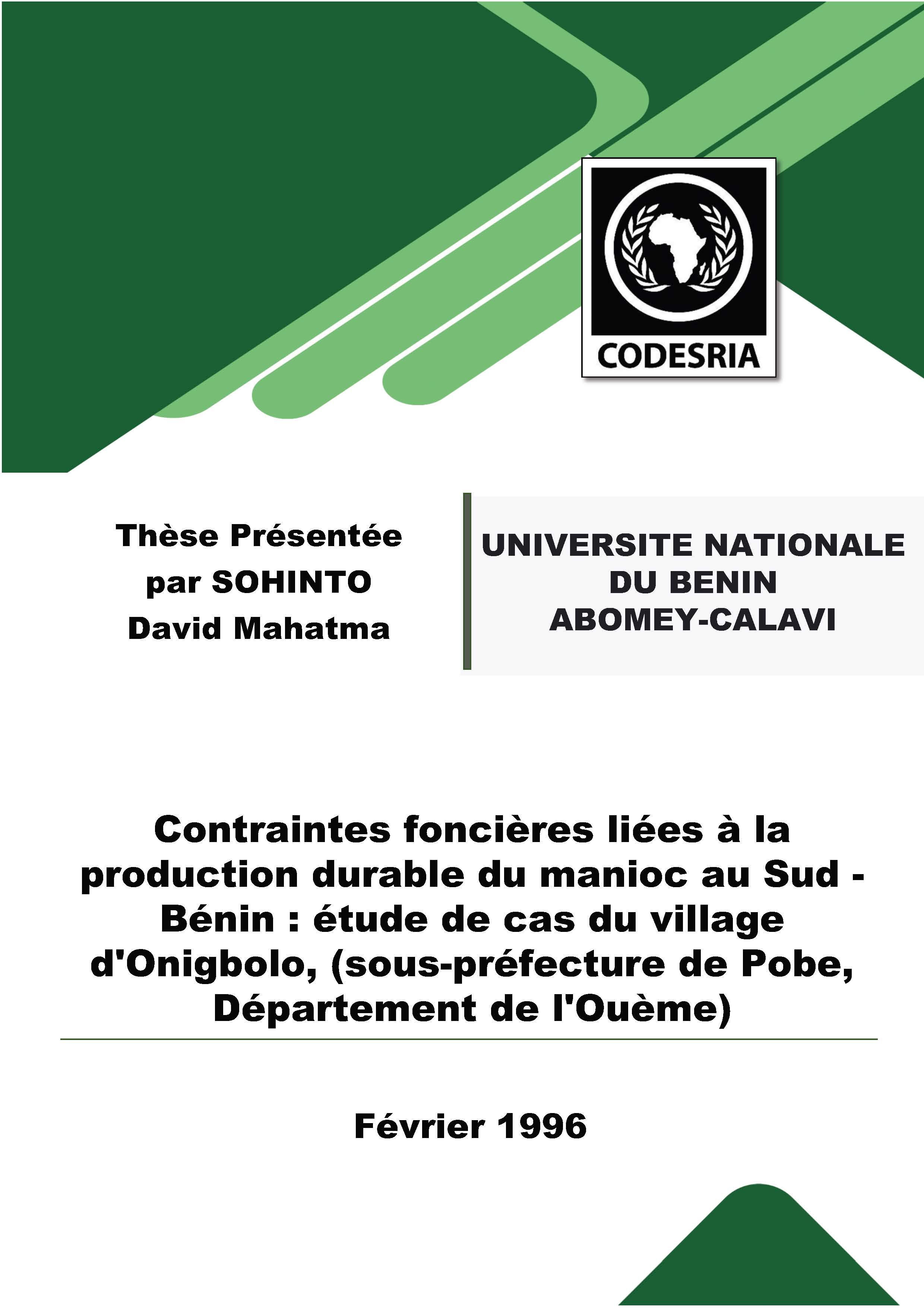Contraintes foncières liées à la production durable du manioc au Sud - Bénin : étude de cas du village d'Onigbolo, (sous-préfecture de Pobe, Département de l'Ouème)
Keywords:
production durable, manioc, Sud - Bénin, OnigboloSynopsis
Cassava plant is a tropical crop which is of much great socio-economic importance. Emphasis must be put on its producHon in developing countries where food shortage creates difficulties.
Apart from the activities which its traditional transformation offers many women in rural areas, cassava represents a plant energy grown at a lower price on poor soils. ln south of Benin, food "crops production in general and cassava production in particular faces land's problems due to soil poverty whose availability is being reduced because of population growth.
ln our country, traditional croping systems which are space consuming are disquieting. The improvement of cassava plant production should not depend on a vast expanse of land. Given that the improvement of cassava production is a partial solution to food shortage crises, 1'11 confine my study to a branch of the IIT A program through the ESCaPP project. The soèio-economic abject of the program has to do with the identification of constraint and potentialities of cassava plant production in certains areas in South of Benin in order to seek means of adequate and sustainable solutions to the problems of productive resources allocation.
My study has tried to answer an important question about ONIGBOLO village. The question takes the following form :
How do cassava producers react to land's shortage and poorness and what intensification possibilities do their develop according to endogenous knowledge? The methodology is centralized on a study about local dynamics developed
among the cassava base croping systems and techniques in link with land tenure and land constraints. The choice is methodologic and (is to my opinion) practical because there is no sustainable development without real and pragmatic solutions.
BOSERUP'S and BIAOU's, and FLOQUET's theses which I have confronted with African literature on the following dualist questions : sustainable agriculture and rural poverty on the one hand and sustainable agriculture and ,landed resources
shortage on ,the other hand, have been the methodological guide to my study whose main and specific abjects are to :
- study fallow system periods and frequencies in link with the landed constraints and status "" examine the sustainable dimensions of cassava croping system and technique in relationship with want of landed resources.
- know whether the land's stability and availability influences the adoption of a long cassava cycle croping or system as a means of its storage or planted fallow system. As far as the specific, statistic, and econometric analyses are concerned, 1 have noticed that :
- the above mentioned village is situated in a milieu where the land's pressure is less strong but because of land availability the farmers are either obliged to shorten the fallow system period to 2 years or not to practise it at all. The agrarian system is characterized by many plots which have been under permament croping system for 15 years.
- The effect of land's security and availability is not all.that significative on cassava based-croping system. What is significative is the farmer's sexual nature. But the cassava preceding crop fertilization characterizes large scale farmers practices.
- The process of intensification among these croping systems is both endogenous (crop association, rotation etc) and exogenous (adoption of impoved varieties, manuring of cassava preceding crop with minerai fertilizers NPK ... ).
- For the same kind of variety adopted by the farmers, the long cycle of its production as a means of storage of the root depends on the land's availability.
- Farmers have not adopted the biologie techniques of keeping and restauration of the soils fertility (agro-forestry technique, mucuna, etc ... ). But lt was noticed that women and small scale farmers use to introduce leguminous in the crop rotation.
Downloads
References
FANOU, A. J. (1987) : Cadres sociaux et organisation foncière de la production agricole au Bénin. Le cas du plateau Adja (Mono). Mémoire de DEA en sociologie du développement des sociétés contemporaines (option tiers monde). Lille : Université des Sciences et Techniques.
FLOQUET, A. (1993) : Agriculture durable au Sud du Bénin : la contribution des innovations autochtones des paysans du département de l'Atlantique. Communication au séminaire sur « Agriculture durable». Cotonou - University of Amsterdam.
GBESSEMEHLAN, V. V. (1988) : Crise agraire et stratégies paysannes dans le Sud est du Bénin. Etude de cas des districts ruraux d' Avrankou et d' AkproMissérété, Province de l'Ouémé. Thèse d'ingénieur Agronome. Abomey-Calavi. FSA/UNB
HONLONKOU A. N. (1994) : Pression foncière, intensification et crédit agricole au BENIN. Etude comparative de cas du plateau ADJA et de la savane de LONKLY. Thèse d'ingénieur Agronome. UNB - FSA - Ab-Cal.






